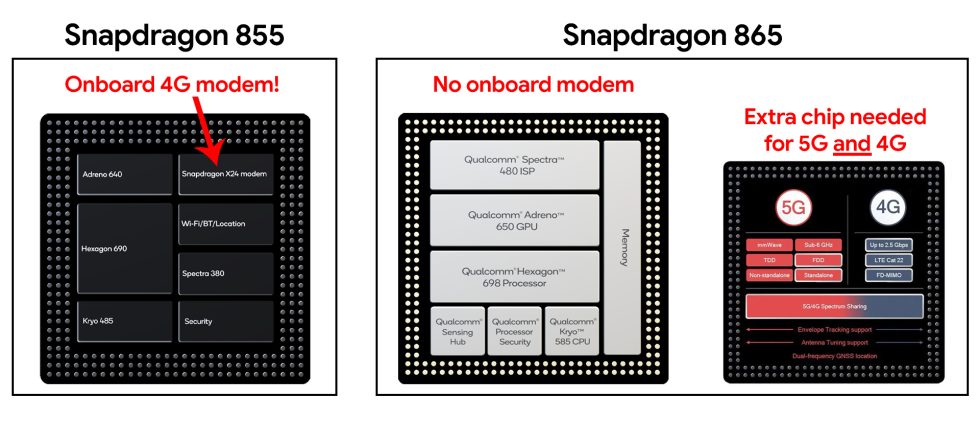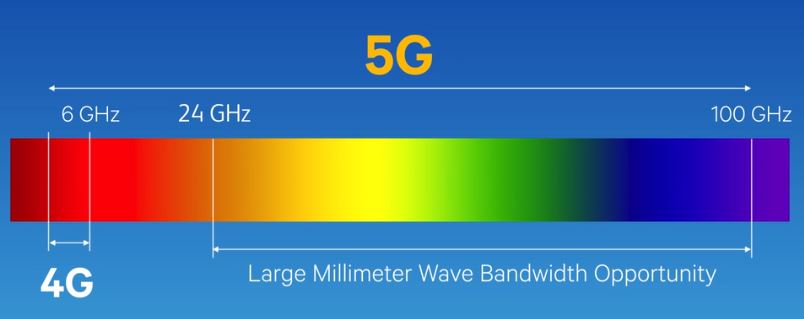Qualcomm recently took the wraps off its flagship SoC for 2020, the Snapdragon 865. As usual, we can expect this chip in all the high-end Android smartphones in 2020, and it's 25 percent faster than last year, with fancy new camera features and AI-accelerating co-processors. What's unusual is the way Qualcomm designed the LTE modem in the Snapdragon 865: it doesn't have one.
This means nearly every flagship Android phone will be a 5G phone in 2020, and putting the 5G and 4G on a giant extra chip means smartphones are going to use way more power, no matter which cell network you're connected to. When 5G networks are only going to be in their infancy in 2020, this sounds like an across-the-board downgrade to me.
In 2019, 4G had a big power and size advantage over 5G thanks to the all-in-one SoC with an integrated modem solution. In 2020, Qualcomm is so desperate to make 5G a thing that it's making 4G worse.
More power-hungry modems for everyone

We've spent the past year railing against early 5G hardware from Qualcomm because 1) the networks it supports barely exist and 2) the hardware requires significant compromise in your smartphone design, even if you never use 5G. The whole reason a modern smartphone works so well is due to the SoC, the System on a Chip.
This combines every major computing component onto a single chip, which you can see in the diagram above. There's a CPU, GPU, an "ISP" for camera functionality, a Qualcomm "Hexagon" co-processor, Wi-Fi, Bluetooth, and—in every flagship SoC released in the last seven years except for the Snapdragon 865—an onboard cellular modem. Mashing everything into a single chip saves power, and it saves space, which means room for a bigger battery.
We've already seen what happens when Android phones ship with separate modems. The first 4G phones with separate modems, like the HTC Thunderbolt, were legendary disasters. The Thunderbolt was a hot, slow, buggy mess, and it had a battery life of only a few hours. It was so bad that one HTC employee even apologized for releasing it. Qualcomm's 2019 5G package was the Snapdragon 855 with a separate X50 modem, and those were fireballs, too.
PCMag's Sascha Segan has been on the road testing 5G networks, and he wrote that heat was a constant issue:
On a hot Las Vegas morning, my two Galaxy S10 5G phones kept overheating and dropping to 4G. This behavior is happening with all of the millimeter-wave, first-generation Qualcomm X50-based phones when temperatures hit or exceed 85 degrees. We saw it with T-Mobile in New York, with Verizon in Providence, and now with AT&T in Las Vegas. It's happened on Samsung and LG phones, with Samsung, Ericsson, and Nokia network hardware.
While this has so far only been an issue with 5G phones, the Snapdragon's 865 could make it an issue with all flagship phones, even when using 4G LTE.
We can let Qualcomm explain the disadvantages of a separate modem in its own words, if we go back to this 2012 press release. That's when the company talks up the single-chip LTE solution it debuted in the Snapdragon S4. "Typically, the more chips that are involved in building a device, the more challenging it is to conserve battery life while maintaining performance," Qualcomm wrote then. "Consolidation means good things for your battery."
Qualcomm threw all that out the window with the Snapdragon 865. At least with the 2019 5G design—with its onboard 4G modem and the extra 5G chip—you could turn off the extra 5G chip and just use the SoC's onboard modem with the usual power savings. Now, with no onboard modem at all, even in 4G-only mode you'll be using more power by needing to light up that second chip.
Smartphone manufacturers have spent the past few years aggressively protecting the space used by components. How many manufacturers have we seen remove headphone jacks, telling us they need the space to simplify the design and free up more space for batteries? And a 3.5mm headphone jack is useful. When 5G networks remain so limited, who would want to waste so much extra internal space on 5G hardware that might never be used?
So far, the industry's response to 5G's bigger space requirements has been to make smartphones even larger. Consider the Galaxy S10 as a data point: you can get 4G versions like the 6.1-inch Galaxy S10 and the 6.4-inch Galaxy S10+, but if you want 5G, you will have to pick up the ultra-huge 6.7-inch Galaxy S10 5G, which is basically a new S10++ sku. For the Galaxy S11's 2020 release (which, remember, has to have 5G in every model), rumors point to across-the-board size increases for every model.
Financially, it's easy to see why Qualcomm made this decision. The company is probably going to make a ton of money on the Snapdragon 865, since every phone manufacturer using the 865 has to also purchase a separate modem. Qualcomm gets to sell double the amount of chips compared to last year! Since Qualcomm, according to the Federal Trade Commission, has a monopoly on high-end smartphone chips, no one can do much about this. Instead, the public will pony up for this design change in the form of more expensive devices.
We already have some data points for what the increased size, additional chips, and greater complexity mean for the cost of 5G phones. A year ago, OnePlus CEO Pete Lau told The Verge that 5G would raise the price of phones by $200 to $300, and that's about what we've seen in the market. The 5G version of the OnePlus 7T Pro costs $900 in the United States, while a similarly configured 4G OnePlus 7 Pro was $750. A Galaxy S10+ is $1,000, while a Galaxy S10 5G is $1,300. Plus, don't forget some carriers will charge extra every month for 5G—on Verizon, your bill will increase $10 a month.
Pick your poison: Sub-6GHz or mmWave 5G
5G will be a requirement for any phone with a Snapdragon 865, but there are two kinds of 5G that manufacturers can choose to implement.
So first—some definitions.
"5G" with no other qualifiers doesn't mean a lot because, as in the early days of 4G, the cell carriers are shameless about misleading the general public and will label anything with the "5G" stamp if they think it will help sales. The biggest abuser is AT&T, which one day just decided to label its entire 4G LTE network as "5G," with no technical upgrades made.
In the United States, honest uses of "5G" over the last year have mostly meant "mmWave," which uses a big chunk of higher-frequency spectrum (24GHz and above) for big speed increases. This spectrum is available because it's actually not that great at hosting a radio signal, and it comes at a cost of greatly reduced range, reduced signal penetration, and more complicated, power-hungry mmWave hardware. Implementing mmWave is a technical nightmare. When corporations talk about how 5G will revolutionize the way you watch cat videos or whatever, they're talking about mmWave.

The other kind of 5G is "sub-6GHz" 5G, which lives in the lower bands and offers only modest speed increases. In the US, carriers have started rolling out sub-6GHz, but the reason they focus so much on mmWave is because that 24GHz-and-above frequency is available in the US, while sub-6GHz frequencies are quite limited. The implementation of sub-6GHz is considerably more doable than mmWave, with less extra handset hardware and a longer range. International mentions of "5G" in 2019 almost always meant "sub-6GHz." Other countries have auctioned off sub-6GHz frequencies for 5G, but the US has not.
Verizon's first public mmWave speed test hit an outrageously fast 760Mbps down. This was done under ideal conditions—right next to the mmWave tower and with no other traffic to contend with, but it's still a staggering speed for a mobile network. Sub-6GHz 5G was recently launched by T-Mobile, and the results are markedly less dramatic—the company says to expect 20 percent speed increases. PCMag's hands-on testing of T-Mobile's sub-6GHz 5G peaked at 297Mbps—but in some locations it dropped to 51Mbps, slower than 4G networks in the area.
Back to Qualcomm's chip packaging decisions. Snapdragon 865 phones will all support some form of 5G, but which one will be used is up to the manufacturer. The mandatory X55 modem supports both sub-6GHz and mmWave, so it sounds like all phones will at least come with sub-6GHz support. If you want mmWave, that takes more work, and it will be something you have to design the entire phone around. MmWave penetration is so poor that your hand can block the signal. Qualcomm's solution to this problem is to buy more chips from Qualcomm, in the form of multiple QTM525 mmWave antenna modules, which can be placed all around the phone. By putting these mmWave antennas into the phone, allowing for reception at the top, bottom, and sides of the device, you can hopefully prevent the "you're holding it wrong" scenario, allowing for 5G reception in any orientation. Again, though, this just contributes to 5G's big problems: these antenna modules are sizable chips, and you'll have an even bigger, more expensive, more complicated phone.
Qualcomm is rushing 5G, just like it rushed 64-bit
Assuming the Snapdragon 865 turns out to be as big of a regression in practice as it looks now on paper, this won't be the first time Qualcomm has totally borked the smartphone upgrade cycle for the entire year. Toward the end of 2013, Apple unveiled the world's first 64-bit smartphone, the iPhone 5S, and it wasn't running a Qualcomm chip. Apple completely shocked Qualcomm by beating it to a 64-bit mobile SoC—one report even quoted a Qualcomm insider as saying it set off a "panic" inside the company. Qualcomm set about rushing a 64-bit flagship SoC out the door, and just over a year later, the Snapdragon 810 was born.
The Snapdragon 810 is infamous for being Qualcomm's worst yearly upgrade ever. The fast turnaround time resulted in a chip that was extremely hot. It throttled constantly, to the point that it was hard to see the SoC ever hit its 2GHz rating. When it was warm, it turned in benchmark scores that were lower than the previous year's Snapdragon 801, and the battery life was terrible. Samsung actually dumped the chip from the Galaxy S6, citing overheating concerns, and shipped it worldwide with its own Exynos SoCs instead. No one else really got out of 2015 unscathed, and it was a bad year for Android phones.
That Qualcomm insider mentioned above even admitted there was no technical reason to be in such a rush with 64-bit. "It's not that big a performance difference right now, since most current software wont benefit," the insider said.Read More – Source







